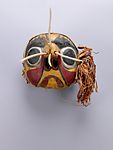hamsalagamł (Mask)
About this object
History of use
Used in the Bumblebee dance, which is a children's dance and is often one of the first dances a child participates in during the Winter Ceremonial among the Musgamagw Dzawada'enuxw.
Narrative
Used in potlatch by Alec Nelson, Kingcome Inlet, 1938.
Iconographic meaning
Represents a bumblebee. In the dance, a father and mother bee lead progressively smaller bees out onto the dance floor one by one. When the children are led back into their 'beehive' at the end of the dance one child is discovered to be missing. The father bee circles the floor four times searching for this lost child. On the fourth round the child is found hidden amongst the spectators and is led home.
Physical description
Small circular bumblebee mask with large bulbous eyes. Nose protrudes and is turned upwards. Strips of cedar bark are attached to one side of the mask. Cloth hood and cording is attached to the back of the mask. Colours used are yellow, red, green, white and black.
